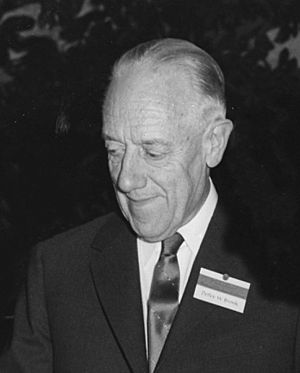Detlev Bronk facts for kids
Quick facts for kids
Detlev Bronk
|
|
|---|---|

Bronk in 1963
|
|
| 3rd President of Rockefeller University | |
| In office 1953–1968 |
|
| Preceded by | Herbert Spencer Gasser |
| Succeeded by | Frederick Seitz |
| 16th President of the National Academy of Sciences | |
| In office 1950–1962 |
|
| Preceded by | Alfred Newton Richards |
| Succeeded by | Frederick Seitz |
| 6th President of Johns Hopkins University | |
| In office 1949–1953 |
|
| Preceded by | Isaiah Bowman |
| Succeeded by | Lowell Reed |
| Personal details | |
| Born |
Detlev Wulf Bronk
August 13, 1897 New York City |
| Died | November 17, 1975 (aged 78) New York City |
| Alma mater | Swarthmore College University of Michigan |
| Awards | Franklin Medal (1961) Presidential Medal of Freedom (1964) Public Welfare Medal (1964) National Medal of Science (1968) Fellow of the Royal Society |
| Scientific career | |
| Fields | Scientist |
| Institutions | Johns Hopkins University National Academy of Sciences National Science Board University of Pennsylvania Rockefeller University World Academy of Art and Science |
| Thesis | Electrical conductivity, electrical potential and hydrogen ion concentration measurements on the submaxillary gland of the dog, recorded with continuous photographic methods (1926) |
| Doctoral advisor | Robert Gesell |
Detlev Wulf Bronk (born August 13, 1897 – died November 17, 1975) was an important American scientist, teacher, and leader. He is known for helping to make biophysics a well-known field of study. Biophysics is a science that uses physics to understand how living things work. Bronk was president of Johns Hopkins University from 1949 to 1953. He also led The Rockefeller University from 1953 to 1968. From 1950 to 1962, Bronk was the president of the National Academy of Sciences.
Contents
About Detlev Bronk
Detlev Bronk came from a family that settled in America a long time ago. His ancestor, Jonas Bronck, is the person for whom The Bronx, a borough in New York City, is named.
In 1920, Bronk earned a degree in electrical engineering from Swarthmore College. He later married Helen Alexander Ramsey, who was also a student there. Bronk then became very interested in physics. He earned his master's degree in physics in 1922 from the University of Michigan. By 1924, he wanted to use physics and math to understand how living bodies work. He earned his Ph.D. in this new field in 1926, also from the University of Michigan.
Bronk's Work and Leadership
Detlev Bronk was a leader in science and education for many years. He believed that universities should help students prepare to make the world better.
Leading Johns Hopkins University
In 1948, Bronk was asked to become president of Johns Hopkins University. He agreed, but only if the university would make its biophysics program stronger. Johns Hopkins agreed and built a special building called Jenkins Hall in 1950. This building was made just for biophysics research and teaching. They also added more teachers and research tools.
Bronk felt that after World War II, universities needed to focus again on learning and discovery. During the war, many professors had worked on defense projects. He often talked about the importance of a broad education and encouraging curiosity in students. He saw a university as a place where many smart people learn and work together.
Involvement in National Science
Besides leading Johns Hopkins, Bronk stayed very active in the wider scientific community. He was the president of the National Academy of Sciences. He also served on important boards for groups like the American Association for the Advancement of Science. He was part of the Science Advisory Committee for defense planning. He also worked with the National Advisory Committee for Aeronautics, which later became NASA.
The "New Plan" for Education
Bronk also tried to change how students entered Johns Hopkins University. In 1952, he supported a plan to stop accepting first and second-year students. Under this "New Plan," Johns Hopkins would only accept students who had already completed two years at another college. These students would then work directly towards a higher degree, like a doctorate. However, this idea did not get much support from students. The plan was quietly stopped by the mid-1950s.
Leading The Rockefeller University
From 1953 to 1968, Bronk was the president of The Rockefeller University. (It was called The Rockefeller Institute for Medical Research until 1965). He strongly believed in academic freedom. This means that teachers and researchers should be free to explore ideas without fear. He resisted efforts by some politicians to have a professor dismissed from Johns Hopkins University.
In 1964, he received the Public Welfare Medal from the National Academy of Sciences. He is known for helping to create the modern understanding of biophysics. He also served on the board of trustees for Science Service, which is now called Society for Science & the Public.
Bronk once said:
A great deal of undergraduate education is built on ... telling a student what to do—at the very time he is developing intellectual habits for life. Too rarely is a student told, "This is the problem with which we are going to deal. Here are the books."
He meant that students should be given problems to solve and resources to use, rather than just being told what to do. This helps them learn how to think for themselves.

